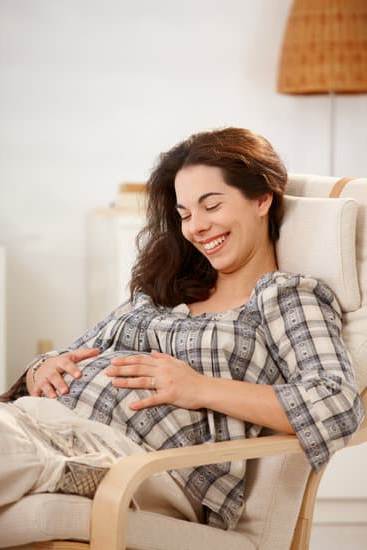When do you start showing in pregnancy? Understanding the timeline of pregnancy and the physical changes that come with it is a common concern for many expecting mothers.
The journey of pregnancy is filled with a multitude of changes, both internally and externally, as the body prepares to nurture and grow a new life. From the first trimester to embracing the changes and dressing your growing bump, this article will provide insight into when you can expect to start showing during pregnancy, and how different factors can influence this process.
The first trimester is an exciting time as your body begins to undergo significant changes in preparation for the arrival of your baby. However, for many women, this period may not yet result in a noticeable baby bump.
Factors such as individual differences, body type, and genetics can all play a role in when you start showing during pregnancy. It’s important to remember that every woman’s experience is unique, and there is no one-size-fits-all answer to this question.
As we explore the early signs of pregnancy before the actual bump appears, it’s essential to recognize that these signs are not solely physical. From fatigue and morning sickness to heightened emotions, the initial stages of pregnancy are characterized by a range of symptoms that may indicate the beginning of this transformative journey. Understanding these subtle changes can help prepare you for what lies ahead as your body continues to adjust and grow throughout each trimester.
The First Trimester
During the first trimester, which lasts from weeks 1 to 12, many women may not visibly show a baby bump. This is especially true for first-time mothers and those with a smaller frame. However, some women may begin to notice subtle changes in their abdomen as early as 12 weeks.
Physiological changes during this stage are more internal in nature. Hormonal fluctuations can cause symptoms like breast tenderness, morning sickness, fatigue, and increased urination – all signs that the body is preparing for pregnancy. The uterus also begins to expand to make room for the growing fetus, although this may not yet be visible from the outside.
It’s important to note that every pregnancy is unique and the timeline for when you start showing can be different for each woman. Factors such as body type and genetics play a role in when a pregnant woman starts to display a noticeable baby bump.
Additionally, women carrying multiples may start showing earlier due to the increased size of their uterus. Ultimately, it’s essential for expectant mothers to embrace these physical changes and focus on staying healthy throughout each stage of their pregnancy journey.
| Weeks Into Pregnancy | Visible Baby Bump |
|---|---|
| 1-6 | No visible change in abdomen |
| 7-12 | Some women may begin noticing subtle changes in abdomen |
Factors That Influence When You Start Showing
During pregnancy, the timeline of when a woman starts showing varies from person to person. Factors such as individual differences, body type, and genetics all play a role in determining when a pregnant woman’s bump becomes noticeable. Here are some key factors that influence when you start showing in pregnancy:
1. Individual Differences:
Every woman’s body is unique and may react differently to the changes that come with pregnancy. Factors such as muscle tone, abdominal strength, and pelvic size can all contribute to when a woman starts showing. Some women may start showing earlier due to their body structure, while others with different individual differences may not show as early.
2. Body Type:
A woman’s body type can also impact when she starts showing during pregnancy. Women with a smaller frame or those who are more petite may notice their bump sooner than women with larger frames. Additionally, women who have had previous pregnancies may show earlier in subsequent pregnancies due to changes in their abdominal muscles.
3. Genetics:
Genetics can also play a significant role in determining when a woman starts showing during pregnancy. Women who come from families where pregnancy bumps tend to show early or prominently may experience the same genetic predisposition.
Ultimately, the timeline of when a pregnant woman starts showing is influenced by a combination of these factors and can vary greatly from one woman to another. It’s important for expectant mothers to understand that every pregnancy is different and there is no “one-size-fits-all” answer to when they will start showing.
Understanding how these factors influence the appearance of a baby bump is essential for expectant mothers as they navigate the physical changes that come with pregnancy.
Recognizing the Early Signs of Pregnancy
Pregnancy is an exciting and life-changing experience, and for many women, the first signs of pregnancy can be both thrilling and nerve-wracking. While some women may start showing a visible baby bump as early as 12 weeks, others may not show until much later in their pregnancy. However, before the bump appears, there are several early signs that can indicate pregnancy.
Some of the earliest signs of pregnancy include missed periods, fatigue, nausea or morning sickness, breast tenderness, increased urination, and food aversions or cravings. These symptoms can vary greatly from woman to woman and may not be experienced by everyone. It’s important to remember that these signs can also be attributed to other factors besides pregnancy, so it’s crucial to take a pregnancy test for confirmation when these symptoms arise.
It’s important for women to listen to their bodies and pay attention to any changes they may be experiencing. Additionally, seeking regular prenatal care with a healthcare provider is essential for monitoring the progress of the pregnancy and ensuring the health and well-being of both the mother and baby. In the next section we will discuss how a growing baby affects your body during your first trimester.
- Missed periods
- Fatigue
- Nausea or morning sickness
- Breast tenderness
- Increased urination
- Food aversions or cravings
The Second Trimester
During the second trimester of pregnancy, the body undergoes significant changes as the baby grows and develops. This period, which typically spans from weeks 13 to 27, is often referred to as the “honeymoon phase” of pregnancy because many women experience relief from the early symptoms such as nausea and fatigue. This trimester is also when most women begin to visibly show their pregnancy, as the baby bump becomes more pronounced.
Physical Changes
One of the most noticeable changes during the second trimester is the growth of the baby bump. As the uterus expands to accommodate the growing fetus, women may notice a roundness in their abdomen that becomes more prominent as the weeks go by.
Additionally, many women experience changes in their breast size and shape during this time, as well as potential skin changes such as stretch marks or pigmentation. The body also undergoes internal changes to support the developing baby, including increased blood volume and pressure on organs such as the bladder and digestive system.
Baby Development
The second trimester is a crucial period for fetal development. By week 14, the baby’s major organs have formed and are beginning to function, and by week 20, many women have their mid-pregnancy ultrasound where they can see detailed images of their baby’s growth. During this time, the baby’s movements become more pronounced and can be felt by the mother. The developing fetus also goes through rapid growth in size and weight during this trimester.
Health Considerations
While every woman’s pregnancy journey is unique, it is essential for expectant mothers to regularly visit their healthcare provider during this time to monitor both fetal development and maternal health. It is also a good idea for pregnant women in their second trimester to discuss with their healthcare provider any concerns about physical discomforts or any abnormal signs or symptoms that may arise.
It’s an exciting time for prospective parents when do you start showing in pregnancy?
When Do You Start Showing With Multiples
When it comes to pregnancy, the timeline for showing can vary depending on whether a woman is carrying one baby or multiples. In general, women who are expecting twins or more may start showing earlier than those carrying a single baby.
This is due to the fact that the uterus expands more quickly to accommodate multiple babies, leading to a visible bump sooner. While every pregnancy is unique and individual factors play a role, it is common for women pregnant with multiples to start showing as early as 12-16 weeks.
The size of the belly during a multiple pregnancy can also depend on where the babies are positioned in the uterus. For example, if one baby is positioned towards the front of the abdomen, it may be more noticeable from an earlier stage compared to if both babies are situated towards the back. Additionally, factors such as maternal age and previous pregnancies can influence when a woman carrying multiples starts showing.
It’s important for women expecting multiples to be mindful of their changing bodies and embrace the unique experience of carrying more than one baby. As with any pregnancy, self-care and staying in tune with one’s body are essential during this exciting time. Seeking out support from healthcare providers, online communities, and other mothers of multiples can also help expectant moms navigate the changes they experience when showing with multiples.
| Topic | Data |
|---|---|
| Start of showing with multiples | 12-16 weeks |
| Influence of uterine position | Affects visibility of bump during pregnancy |
| Importance of self-care | Mindfulness and seeking support |
Embracing the Changes
During pregnancy, women experience a myriad of changes both physically and emotionally. As the body begins to show signs of pregnancy, it is common for women to feel a range of emotions about their changing appearance. It is important for expectant mothers to understand that these changes are natural and embrace the journey of motherhood.
One of the most significant physical changes during pregnancy is the growing belly. For some women, this can be an exciting and empowering experience as they watch their body transform to accommodate new life. However, for others, it may bring feelings of insecurity and uncertainty about their changing body image. It is important for women to remember that every pregnancy is unique and there is no “one size fits all” when it comes to showing during pregnancy.
In addition to the physical changes, pregnancy can also influence a woman’s self-esteem. Hormonal fluctuations and the anticipation of motherhood can bring about emotional highs and lows. It is crucial for pregnant women to prioritize self-care and maintain a positive mindset throughout this journey. Seeking support from loved ones, joining prenatal classes, or connecting with other expectant mothers can help boost self-esteem and foster a sense of community during this transformative time.
Overall, embracing the changes that come with pregnancy involves accepting and celebrating the body’s ability to nurture and sustain new life. By focusing on self-care, seeking emotional support, and practicing self-love, expectant mothers can navigate this period with confidence and grace.
Tips for Dressing Your Growing Bump
During pregnancy, one of the most exciting and visible changes is the growth of your bump. As the baby grows, so does your belly, and it’s important to find comfortable and stylish clothing that accommodates your changing shape. Here are some tips for dressing your growing bump that will help you feel confident and fashionable throughout your pregnancy.
Invest in Maternity Basics
As your belly starts to grow, you may find that your regular clothes no longer fit comfortably. Investing in maternity basics such as maternity jeans, leggings, and tops can make a world of difference in how you feel and look. These pieces are designed to accommodate a growing bump and provide the necessary support for your changing body.
Choose Flowy and Stretchy Fabrics
When shopping for maternity clothes, look for fabrics that are flowy and stretchy. Maxi dresses and skirts made from stretchy materials will not only be comfortable but also allow room for your bump to grow. Flowy tops and tunics are also great options as they provide coverage while still being stylish.
Accessorize With Belts and Scarves
If you want to add some flair to your maternity wardrobe, consider accessorizing with belts or scarves. Adding a belt above or below your bump can accentuate your new shape and create a more defined silhouette. Scarves can also be used to draw attention to other parts of your body or add pops of color to your outfit.
By following these fashion and style tips, you can embrace the changes in your body during pregnancy with confidence and grace. Remember, every woman’s body is different, so it’s important to find clothing that makes you feel comfortable and beautiful at this special time in your life.
Conclusion
In conclusion, the timeline of pregnancy and the physical changes that come with it are unique to each woman. The first trimester brings subtle changes, such as breast tenderness and fatigue, before the baby bump starts to show.
Factors such as individual differences, body type, and genetics also play a role in when a woman may start showing in pregnancy. It is important for expectant mothers to recognize the early signs of pregnancy before the bump appears, as this can help them better prepare for the changes that lie ahead.
As the second trimester begins, the growth of the baby becomes more noticeable, and women often start showing during this stage. However, for those carrying multiple babies, the timeline for when they start showing may vary. Embracing these changes is an important aspect of pregnancy, as it allows women to maintain a positive body image and self-esteem during this exciting time. Additionally, there are fashion and style tips available to help women dress their growing bump comfortably and confidently.
For women experiencing this exciting stage of pregnancy, it is crucial to remember that every pregnancy journey is unique. While some may start showing earlier than others, what truly matters is embracing the changes happening within your body and staying healthy throughout the process.
As you navigate through each trimester and witness your body transform in incredible ways, take comfort in knowing that you are not alone on this journey-and that soon enough, you will be welcoming your little one into the world.
Frequently Asked Questions
Can You Start Showing at 8 Weeks?
It is possible to start showing at 8 weeks, but it varies from person to person. Some may begin to show earlier due to factors such as body shape, muscle tone, and if it’s not a first pregnancy.
When Does Baby Bump Grow the Most?
The baby bump tends to grow the most during the second trimester, typically between weeks 18 and 24. This is when the fetus experiences rapid growth, leading to a noticeable increase in the size of the belly.
Can You Start Showing at 10 Weeks?
While every pregnancy and body is different, many women do not start showing at 10 weeks. At this stage, the uterus is still within the pelvic area and hasn’t yet grown enough to be visibly protruding. However, some may notice slight changes in their abdomen due to bloating or other factors during this time.

Welcome to my fertility blog. This is a space where I will be sharing my experiences as I navigate through the world of fertility treatments, as well as provide information and resources about fertility and pregnancy.





